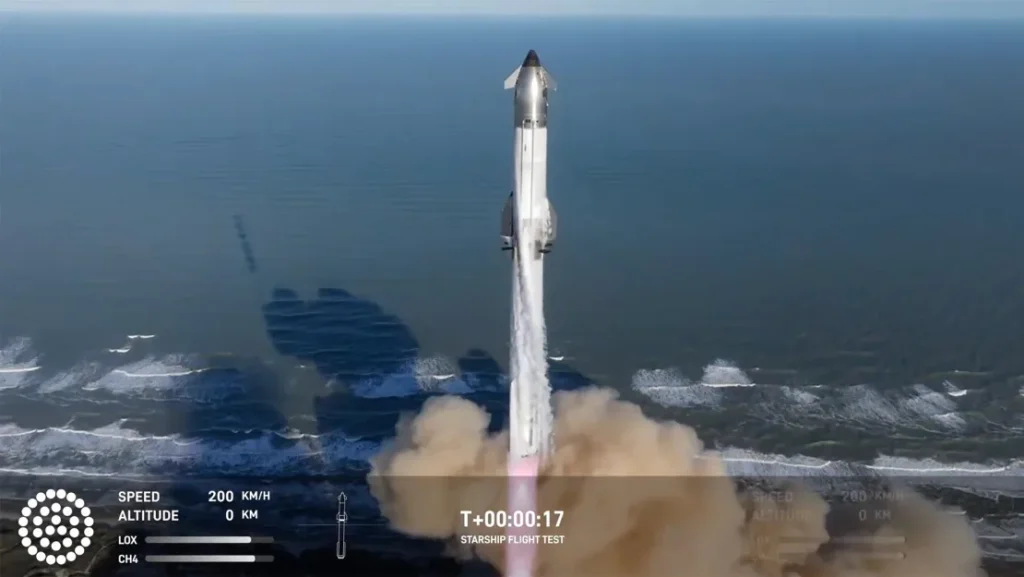SpaceX’s Starship rocket system launched on its seventh uncrewed test flight on Thursday, marking the most ambitious mission to date for the company’s massive megarocket. While SpaceX successfully repeated its prior achievement of catching the returning booster, the Starship spacecraft itself was lost about 8.5 minutes into its flight.
“Starship underwent a rapid unscheduled disassembly during its ascent burn,” SpaceX reported on X, the platform formerly known as Twitter. “Our teams will analyze data from today’s flight to understand the cause. With tests like this, success is defined by the lessons we learn, and today’s flight will help improve Starship’s reliability.”
The term “rapid unscheduled disassembly” refers to an explosion, which occurred after the spacecraft had reached 90 miles in altitude and was traveling at a speed of 13,200 miles per hour, according to SpaceX’s last telemetry data.
Debris from the explosion was visible over the Turks and Caicos Islands, and aircraft tracking website Flightradar24 reported that nearby flights had to hold or divert to avoid potential debris. The Federal Aviation Administration (FAA) also delayed flights departing from Miami and Fort Lauderdale airports by around an hour due to the “rocket launch anomaly” and subsequent debris.
A pilot reporting from a San Juan air traffic control center described a “major streak” in the sky, warning that it appeared to be heading in their direction. SpaceX founder Elon Musk later shared an image of the debris and appeared to make light of the situation, commenting that “entertainment is guaranteed!”
The launch took place at 5:37 p.m. ET from SpaceX’s Starbase launch site near Brownsville, Texas. The Super Heavy rocket booster, which comprises the first stage of the Starship system, roared to life as it ignited its 33 engines. For the first time, one of these engines had previously flown to space—having been recovered from the booster’s fifth test flight in October.
The Super Heavy booster successfully returned to the launch site, guided back by SpaceX’s “Mechazilla” system—metal arms designed to catch the booster midair. This was only the second time the booster had been successfully captured in such a manner, with the previous instance occurring during October’s test.
However, while the booster’s landing was a success, the Starship spacecraft, the upper stage of the vehicle, failed to continue its journey as expected. The spacecraft lost telemetry data, which led SpaceX to confirm its loss shortly after. “We can confirm that we did lose the ship,” said SpaceX engineer Kate Tice.
The failure occurred shortly before the spacecraft completed its ascent burn. SpaceX later reported that a fire in the spacecraft’s rear section triggered the explosion, scattering debris into the Atlantic Ocean within the designated hazard area.
Following the explosion, SpaceX reassured the public that the spacecraft had flown within the approved launch corridor, ensuring safety for people on the ground, in the water, and in the air. The company also advised people not to handle any recovered debris but to report it to the authorities or the SpaceX Debris Hotline.
Musk addressed the failure, noting that “improved versions of the ship and booster” are already prepared for the next test. He suggested the failure was likely due to an oxygen/fuel leak in a compartment above the engine firewall, which caused pressure to exceed venting capacity. He stated that, aside from addressing potential leaks, SpaceX would likely add fire suppression to that area and possibly increase the venting area.
The mission featured significant upgrades to the Starship vehicle, such as increased fuel capacity and a more powerful flight computer. The vehicle was also equipped with new antennas and navigation systems to improve communication with SpaceX’s Starlink satellite network.
This test also marked the first attempt to simulate how Starship might deploy satellites in the future. Ten dummy payloads, designed to resemble next-generation Starlink satellites, were carried aboard. SpaceX intended to deploy these mock satellites about 17 minutes into the flight, although they were not expected to reach orbit.
The plan also included testing a controlled splashdown of the spacecraft in the Indian Ocean, which would simulate how the vehicle could be recovered in future missions. However, the spacecraft’s failure meant it was discarded into the ocean, as has been the case with previous tests.
SpaceX will now analyze the flight data to determine the cause of the failure. “It’s going to take some time, but in the next hours and days, we’ll figure out what happened and return to flight,” said SpaceX spokesperson Dan Huot. He reminded viewers that the mission was a test of an experimental vehicle, and every test brings SpaceX closer to its long-term goals.

